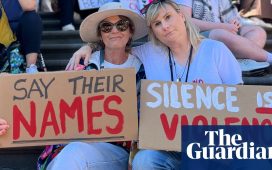In his pitch to voters in March last year, Keir Starmer said he wanted to “imagine a society where violence against women is stamped out everywhere”. His government would, he pledged, halve violence against women and girls in a decade. It was a bold, simple statement, widely welcomed for its ambition.
That something has to change is not in doubt. The first national analysis of the scale of violence against women and girls (VAWG) released in July by the National Police Chiefs’ Council (NPCC) estimated that 2 million women were victims of male violence every year – an epidemic so serious it amounts to a “national emergency”. VAWG crimes account for 20% of all police-recorded crime.
On average, a woman is killed by a man in the UK every three days. One in 12 women in England and Wales will experience stalking, harassment, sexual assault or domestic violence. The number of recorded offences has grown by 37% in the past five years.
So far, the government has given little detail about how it will measure its success. It has, however, already given some indicators of shifts in policy.
Perhaps the most significant is that VAWG will be considered central to the pledge to create “safer streets”, one of the government’s five central “missions”. The home secretary, Yvette Cooper, has said this will mean that all departments are working together to tackle the problem. Jess Phillips, the VAWG minister, told the Guardian that support for victims and effective policing would be crucial, and pointed to already announced policies, adding: “These are the first steps toward what I hope will be real, tangible change.”
Those first steps include:
But what else needs to happen? The Guardian spoke to experts about what steps the government needs to take to have some hope of halving violence against women in a decade.
Half of what, exactly?
It’s no use saying you are going to halve VAWG without clearly stating what indicators you are going to use. The End Violence Against Women Coalition (EVAW) has suggested annual targets to bring down the number of women killed by men. Increases in prosecutions for VAWG-related crimes such as rape and domestic abuse could also be looked at. Katrin Hohl, the government’s independent sexual violence adviser, warns that an approach that is too target-driven risks being counter-productive. “It’s great that the government wants to be held to account, but the focus needs to be on walking the walk, not hitting a headline-friendly target,” she says.
Fix the roof
New policies and laws are headline-grabbing, but in some cases theoretically good systems exist – they just don’t work. Operation Soteria Bluestone, a series of new rape policies brought in after a collapse in prosecutions, has yielded results: police rape referrals to the CPS are up by 219% from the quarterly average in 2019.
Protection orders are a case in point, argues Hohl. Often police don’t know how to use them and courts have no time to hear applications. When imposed, they too often fail to be flagged on internal systems; when breached, nothing is done. “Victims might have actually been placed at more risk because the system is not effective,” she says. “If the government was to reach for existing solutions, fixing the system of protective orders needs to be a priority.”
The chronically underfunded Crown Prosecution Service and a crumbling court system are huge challenges. According to the Criminal Bar Association, there is a “critical” shortage of specialist barristers to prosecute and defend in rape cases.
As of March, the number of sexual offence cases waiting to go to trial was at a record high. The government has promised to establish 80 new rape courts across England and Wales to fast-track cases. “The criminal justice system must treat survivors with compassion, dignity and respect,” says Ciara Bergman, the CEO of Rape Crisis England and Wales. “That’s not possible when they are left in the dark, waiting for court dates that never come or are rearranged at the last minute.”
Education, education, education
Lucy Emmerson, the chief executive of the Sex Education Forum, argues that comprehensive sex education is a crucial preventive tool. Sex and relationships education (RSE) was finally made compulsory in schools in 2019, and student satisfaction with it is growing. But by May this year the previous government was already looking to roll it back, with new draft guidance put forward. That draft needs putting in the bin, she suggests. “The 2019 guidance is still good; it’s still in scope and schools need to be using it,” she says. She argues RSE should be treated like other critical subjects, with a dedicated team of teachers, and be rolled out in higher education, as called for by the youth-led grassroots campaign “Make it Mandatory”.
Data
It’s hard to tackle a problem if you don’t know the full extent of what is going wrong. Existing VAWG data is, at best, patchy and incomplete. Crucially, it often misses the experience of minority groups, a failing noted by the police inspectorate. Hohl says Labour should pinch tools from the previous government’s rape review, such as its data dashboard.
Help perpetrators to stop
Experts also argue that perpetrator programmes have to be part of the solution, despite society’s discomfort with spending money on domestic abusers and sex offenders. A report from the domestic abuse commissioner found that half of female victims wanted their abusers to get help to stop their behaviour, but that happened in only 7% of cases. “Addressing men’s violence through the frame of fatherhood could and should be a much stronger focus of our response to domestic abuse,” says Kathy Jones, the CEO of the Fatherhood Institute, which will next year pilot a “Fathers for Change” programme to help stop violent men reoffending.
But also, stop them
Intervention also means actually stopping dangerous men before they cause devastating harm. The criminal justice system has to be effective to be a deterrent. Offenders – including those in police forces, and for crimes such as flashing, harassment and stalking – should be aggressively pursued and disrupted.
Too often this isn’t happening. A survey of families of women killed by men found that 78% of respondents had suffered a history of abuse that was reported to authorities. “We need a system that focuses on prevention and intervention to stop these crimes happening, but we need it to respond with absolute intolerance when they do,” says Anna Ryder, the director of Killed Women. Victims and families also desperately need support in the aftermath of violence, she adds.
Police chiefs say they know the situation has to improve, and have promised better targeting of offenders through technology and intelligence, which they say will be helped by the creation of a dedicated policing hub, the National Centre for Public Protection.
It’s the funding, stupid
VAWG costs society an estimated £40bn each year. Since last year, violence against women and girls has been officially classed as a national threat in line with counter-terrorism, but, according to insiders, receives a fraction of the funding. The women and girls sector received just 1.8% of a total £4.1bn-worth of grants awarded to charities in 2021. Of these, a third went to organisations with no specific focus on women and girls.
The Ministry of Justice’s current funding for victim support services runs out in March 2025; as yet, there is no replacement plan. “We need money and we need it quickly,” says the CEO of Women’s Aid, Farah Nazeer. Imkaan, a non-profit organisation that delivers specialist services for black and minoritised women, argues that the tendering processes too often cut out specialist organisations. “We need money ringfenced for organisations like ours to continue to provide vital support,” says its co-director Ghadah Alnasseri.
A seat at the table
Charities have called for the women and equalities minister to sit at cabinet level, hold regular interdepartmental meetings, and genuinely engage with the sector to create a new VAWG strategy. Everyone needs to be invested, argues Andrea Simon, the director of EVAW. “Everyone has to have ownership of this agenda and we need to push all together to make it happen,” she says.










